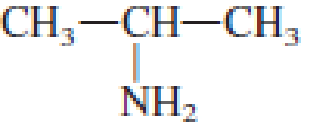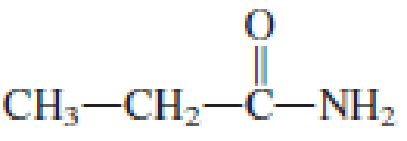
General, Organic, and Biological Chemistry
7th Edition
ISBN: 9781285853918
Author: H. Stephen Stoker
Publisher: Cengage Learning
expand_more
expand_more
format_list_bulleted
Concept explainers
Textbook Question
Chapter 17, Problem 17.7EP
Indicate whether or not each of the following compounds contains an




Expert Solution & Answer
Trending nowThis is a popular solution!

Students have asked these similar questions
29. Use frontier orbital analysis (HOMO-LUMO interactions) to decide whether the following
dimerization is 1) thermally allowed or forbidden and 2) photochemically allowed or
forbidden.
+
30.0 mL of 0.10 mol/L iron sulfate and 20.0 mL of 0.05 mol/L of silver nitrate solutions are mixed together. Justify if any precipitate would form
Does the carbonyl group first react with the ethylene glycol, in an intermolecular reaction, or with the end alcohol, in an intramolecular reaction, to form a hemiacetal? Why does it react with the alcohol it does first rather than the other one? Please do not use an AI answer.
Chapter 17 Solutions
General, Organic, and Biological Chemistry
Ch. 17.1 - Prob. 1QQCh. 17.1 - Prob. 2QQCh. 17.2 - Prob. 1QQCh. 17.2 - Prob. 2QQCh. 17.2 - Prob. 3QQCh. 17.2 - Prob. 4QQCh. 17.3 - Prob. 1QQCh. 17.3 - Prob. 2QQCh. 17.3 - Prob. 3QQCh. 17.3 - Prob. 4QQ
Ch. 17.4 - Prob. 1QQCh. 17.4 - Prob. 2QQCh. 17.5 - Prob. 1QQCh. 17.5 - Prob. 2QQCh. 17.5 - Prob. 3QQCh. 17.6 - Prob. 1QQCh. 17.6 - Prob. 2QQCh. 17.6 - Prob. 3QQCh. 17.7 - Prob. 1QQCh. 17.7 - Prob. 2QQCh. 17.7 - Prob. 3QQCh. 17.8 - Prob. 1QQCh. 17.8 - Prob. 2QQCh. 17.8 - Prob. 3QQCh. 17.8 - Prob. 4QQCh. 17.9 - Prob. 1QQCh. 17.9 - Prob. 2QQCh. 17.10 - Prob. 1QQCh. 17.10 - Prob. 2QQCh. 17.10 - Prob. 3QQCh. 17.10 - Prob. 4QQCh. 17.11 - Prob. 1QQCh. 17.11 - Prob. 2QQCh. 17.11 - Prob. 3QQCh. 17.12 - Prob. 1QQCh. 17.12 - Prob. 2QQCh. 17.12 - Prob. 3QQCh. 17.12 - Prob. 4QQCh. 17.13 - Prob. 1QQCh. 17.13 - Prob. 2QQCh. 17.13 - Prob. 3QQCh. 17.13 - Prob. 4QQCh. 17.14 - Prob. 1QQCh. 17.14 - Prob. 2QQCh. 17.14 - Prob. 3QQCh. 17.15 - Prob. 1QQCh. 17.15 - Prob. 2QQCh. 17.16 - Prob. 1QQCh. 17.16 - Prob. 2QQCh. 17.16 - Prob. 3QQCh. 17.17 - Prob. 1QQCh. 17.17 - Prob. 2QQCh. 17.17 - Prob. 3QQCh. 17.18 - Prob. 1QQCh. 17.18 - Prob. 2QQCh. 17.18 - Prob. 3QQCh. 17.19 - Prob. 1QQCh. 17.19 - Prob. 2QQCh. 17.19 - Prob. 3QQCh. 17.19 - Prob. 4QQCh. 17 - Prob. 17.1EPCh. 17 - Prob. 17.2EPCh. 17 - Prob. 17.3EPCh. 17 - Prob. 17.4EPCh. 17 - Prob. 17.5EPCh. 17 - Prob. 17.6EPCh. 17 - Indicate whether or not each of the following...Ch. 17 - Indicate whether or not each of the following...Ch. 17 - Prob. 17.9EPCh. 17 - Prob. 17.10EPCh. 17 - Prob. 17.11EPCh. 17 - Prob. 17.12EPCh. 17 - Prob. 17.13EPCh. 17 - Prob. 17.14EPCh. 17 - Prob. 17.15EPCh. 17 - Assign a common name to each of the following...Ch. 17 - Prob. 17.17EPCh. 17 - Prob. 17.18EPCh. 17 - Prob. 17.19EPCh. 17 - Prob. 17.20EPCh. 17 - Prob. 17.21EPCh. 17 - Prob. 17.22EPCh. 17 - Prob. 17.23EPCh. 17 - Prob. 17.24EPCh. 17 - Prob. 17.25EPCh. 17 - Prob. 17.26EPCh. 17 - Prob. 17.27EPCh. 17 - Prob. 17.28EPCh. 17 - Prob. 17.29EPCh. 17 - Prob. 17.30EPCh. 17 - Prob. 17.31EPCh. 17 - Prob. 17.32EPCh. 17 - Prob. 17.33EPCh. 17 - Prob. 17.34EPCh. 17 - Determine the maximum number of hydrogen bonds...Ch. 17 - Prob. 17.36EPCh. 17 - Prob. 17.37EPCh. 17 - Prob. 17.38EPCh. 17 - Prob. 17.39EPCh. 17 - Prob. 17.40EPCh. 17 - Prob. 17.41EPCh. 17 - Prob. 17.42EPCh. 17 - Prob. 17.43EPCh. 17 - Prob. 17.44EPCh. 17 - Prob. 17.45EPCh. 17 - Prob. 17.46EPCh. 17 - Prob. 17.47EPCh. 17 - Prob. 17.48EPCh. 17 - Prob. 17.49EPCh. 17 - Prob. 17.50EPCh. 17 - Prob. 17.51EPCh. 17 - Prob. 17.52EPCh. 17 - Prob. 17.53EPCh. 17 - Prob. 17.54EPCh. 17 - Prob. 17.55EPCh. 17 - Prob. 17.56EPCh. 17 - Prob. 17.57EPCh. 17 - Prob. 17.58EPCh. 17 - Prob. 17.59EPCh. 17 - Prob. 17.60EPCh. 17 - Prob. 17.61EPCh. 17 - Prob. 17.62EPCh. 17 - Prob. 17.63EPCh. 17 - Prob. 17.64EPCh. 17 - Prob. 17.65EPCh. 17 - Prob. 17.66EPCh. 17 - Prob. 17.67EPCh. 17 - Prob. 17.68EPCh. 17 - Prob. 17.69EPCh. 17 - Prob. 17.70EPCh. 17 - Prob. 17.71EPCh. 17 - Prob. 17.72EPCh. 17 - Prob. 17.73EPCh. 17 - Prob. 17.74EPCh. 17 - Prob. 17.75EPCh. 17 - Prob. 17.76EPCh. 17 - Prob. 17.77EPCh. 17 - Prob. 17.78EPCh. 17 - Prob. 17.79EPCh. 17 - Prob. 17.80EPCh. 17 - Prob. 17.81EPCh. 17 - Prob. 17.82EPCh. 17 - Prob. 17.83EPCh. 17 - Prob. 17.84EPCh. 17 - Prob. 17.85EPCh. 17 - Prob. 17.86EPCh. 17 - Prob. 17.87EPCh. 17 - Prob. 17.88EPCh. 17 - Prob. 17.89EPCh. 17 - Prob. 17.90EPCh. 17 - Prob. 17.91EPCh. 17 - Prob. 17.92EPCh. 17 - Prob. 17.93EPCh. 17 - Prob. 17.94EPCh. 17 - Prob. 17.95EPCh. 17 - Prob. 17.96EPCh. 17 - Prob. 17.97EPCh. 17 - Prob. 17.98EPCh. 17 - Indicate whether or not each of the following...Ch. 17 - Indicate whether or not each of the following...Ch. 17 - Classify each of the following amides as...Ch. 17 - Classify each of the following amides as...Ch. 17 - Classify each of the amides in Problem 17-101 as a...Ch. 17 - Prob. 17.104EPCh. 17 - Prob. 17.105EPCh. 17 - Prob. 17.106EPCh. 17 - Prob. 17.107EPCh. 17 - Prob. 17.108EPCh. 17 - Prob. 17.109EPCh. 17 - Prob. 17.110EPCh. 17 - Assign an IUPAC name to each of the following...Ch. 17 - Assign an IUPAC name to each of the following...Ch. 17 - Prob. 17.113EPCh. 17 - Prob. 17.114EPCh. 17 - Prob. 17.115EPCh. 17 - Prob. 17.116EPCh. 17 - Prob. 17.117EPCh. 17 - Prob. 17.118EPCh. 17 - Prob. 17.119EPCh. 17 - What is the relationship between the acronym DEET...Ch. 17 - Prob. 17.121EPCh. 17 - Prob. 17.122EPCh. 17 - Prob. 17.123EPCh. 17 - Prob. 17.124EPCh. 17 - Prob. 17.125EPCh. 17 - Prob. 17.126EPCh. 17 - Prob. 17.127EPCh. 17 - Prob. 17.128EPCh. 17 - Prob. 17.129EPCh. 17 - Prob. 17.130EPCh. 17 - Prob. 17.131EPCh. 17 - Prob. 17.132EPCh. 17 - Prob. 17.133EPCh. 17 - Prob. 17.134EPCh. 17 - Prob. 17.135EPCh. 17 - Prob. 17.136EPCh. 17 - Prob. 17.137EPCh. 17 - Prob. 17.138EPCh. 17 - Prob. 17.139EPCh. 17 - Prob. 17.140EPCh. 17 - Prob. 17.141EPCh. 17 - Prob. 17.142EPCh. 17 - Prob. 17.143EPCh. 17 - Prob. 17.144EPCh. 17 - Prob. 17.145EPCh. 17 - Prob. 17.146EPCh. 17 - Prob. 17.147EPCh. 17 - Prob. 17.148EPCh. 17 - Prob. 17.149EPCh. 17 - Prob. 17.150EPCh. 17 - Prob. 17.151EPCh. 17 - Prob. 17.152EPCh. 17 - Prob. 17.153EPCh. 17 - Prob. 17.154EP
Knowledge Booster
Learn more about
Need a deep-dive on the concept behind this application? Look no further. Learn more about this topic, chemistry and related others by exploring similar questions and additional content below.Similar questions
- The number of noncyclic isomers that have the composition C4H8Owith the O as part of an OH group, counting a pair of stereoisomers as1, is A. 8; B. 6; C. 9; D. 5; E. None of the other answers is correct.arrow_forwardNonearrow_forwardThe number of carbon skeletons that have 8 carbons, one of which istertiary is A. 7; B. More than 7; C. 6; D. 5; E. 4arrow_forward
- The azide ion is N3^-. In addition to the ionic charge, it’s three mostimportant contributing structures also have formal charges. The totalnumber of π bonds in these three contributing structures isA. 6; B. 12; C. 3; D. 9; E. None of the other answers is correct.arrow_forwardThe sum of the numerals in the name of the compoundis A. None of the other answers is correct.; B. 11;C. 6; D. 8; E. 5.arrow_forwardA compound has a six carbon ring with three double bonds. Attachedto the ring is a three carbon chain with a triple bond and a two carbonchain with two bromines attached. The number of hydrogens in a molecule of this compound is A. 10; B. 12; C. 14; D. 13; E. None of the other answers is correct.arrow_forward
- Can you help me? I can't seem to understand the handwriting for the five problems, and I want to be able to solve them and practice. If you'd like to give me steps, please do so to make it easier understand.arrow_forwardThe number of 2sp3 hybrid orbitals in the moleculeis A. 12; B. 8; C. 3; D. 11; E. None of the other answers is correct.arrow_forwardNonearrow_forward
arrow_back_ios
SEE MORE QUESTIONS
arrow_forward_ios
Recommended textbooks for you
 General, Organic, and Biological ChemistryChemistryISBN:9781285853918Author:H. Stephen StokerPublisher:Cengage Learning
General, Organic, and Biological ChemistryChemistryISBN:9781285853918Author:H. Stephen StokerPublisher:Cengage Learning Organic And Biological ChemistryChemistryISBN:9781305081079Author:STOKER, H. Stephen (howard Stephen)Publisher:Cengage Learning,
Organic And Biological ChemistryChemistryISBN:9781305081079Author:STOKER, H. Stephen (howard Stephen)Publisher:Cengage Learning, Chemistry for Today: General, Organic, and Bioche...ChemistryISBN:9781305960060Author:Spencer L. Seager, Michael R. Slabaugh, Maren S. HansenPublisher:Cengage Learning
Chemistry for Today: General, Organic, and Bioche...ChemistryISBN:9781305960060Author:Spencer L. Seager, Michael R. Slabaugh, Maren S. HansenPublisher:Cengage Learning- Chemistry: Matter and ChangeChemistryISBN:9780078746376Author:Dinah Zike, Laurel Dingrando, Nicholas Hainen, Cheryl WistromPublisher:Glencoe/McGraw-Hill School Pub Co

General, Organic, and Biological Chemistry
Chemistry
ISBN:9781285853918
Author:H. Stephen Stoker
Publisher:Cengage Learning

Organic And Biological Chemistry
Chemistry
ISBN:9781305081079
Author:STOKER, H. Stephen (howard Stephen)
Publisher:Cengage Learning,

Chemistry for Today: General, Organic, and Bioche...
Chemistry
ISBN:9781305960060
Author:Spencer L. Seager, Michael R. Slabaugh, Maren S. Hansen
Publisher:Cengage Learning

Chemistry: Matter and Change
Chemistry
ISBN:9780078746376
Author:Dinah Zike, Laurel Dingrando, Nicholas Hainen, Cheryl Wistrom
Publisher:Glencoe/McGraw-Hill School Pub Co
Nomenclature: Crash Course Chemistry #44; Author: CrashCourse;https://www.youtube.com/watch?v=U7wavimfNFE;License: Standard YouTube License, CC-BY